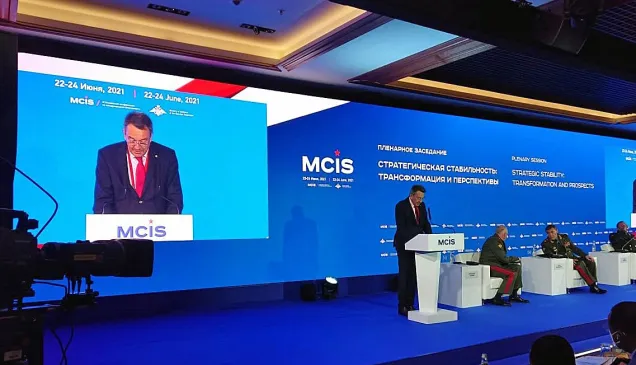Mr. Chairman, excellencies, ladies and gentlemen,
It is a real pleasure to be back at the Xiangshan Forum this year and to have the opportunity to address again this distinguished audience. My thanks go to the organizers and the People's Liberation Army for inviting me to Beijing.
Some of you may wonder what security risk management has to do with a humanitarian organization like the International Committee of the Red Cross (ICRC). The short answer is a lot! A longer answer requires a bit of history and context to highlight why security risk management is important for us, and specifically in the Asia-Pacific region.
The ICRC was created 156 years ago with the purpose of protecting and assisting victims of armed conflict and ensuring respect for international humanitarian law (IHL). Ever since, we have worked on the frontlines in armed conflict – today in Syria, Iraq, Afghanistan, Myanmar, Libya, Yemen, the Sahel and Lake Chad regions, and beyond. In such contexts, assessing and managing security risks is absolutely crucial for our 19,000 staff to gain access to affected people.
Our risk management strategy is based on being accepted by all parties to a conflict in order to fulfill our role as a neutral, impartial, independent humanitarian actor. We need to maintain dialogue with all parties to a conflict, without taking sides, not least to fulfill our mandate of promoting compliance with IHL.
Excellencies, ladies and gentlemen, the People's Republic of China has recently celebrated its 70th Anniversary. Allow me to add my congratulations on this major commemoration. This year also marks the 70th Anniversary of the Geneva Conventions of 1949. Universally ratified, the Geneva Conventions represent the bedrock of the Law of Armed Conflicts or IHL. I am pleased to underline that, remarkably, the People's Republic of China was one of the first States to sign the Geneva Conventions in December 1949, just a few weeks after its creation.
Over the decades, IHL has continued to develop in order to address the humanitarian challenges of contemporary warfare — new treaties have been adopted, a wealth of international and domestic jurisprudence has been created, and many armed forces have trained their troops in IHL, to give but a few examples.
70 years after the adoption of the Geneva Conventions, IHL remains an essential tool for States to deal with contemporary warfare. It continues to strike a pragmatic balance between military necessity and the fundamental principle of humanity. This includes counter-terrorism operations in armed conflict, protecting civilians in urban warfare, or addressing the use of new technologies for military purposes, such as artificial intelligence in autonomous weapon systems and cyber warfare.
Let me add one clarification that many of you, army high-ranking officials, know very well. IHL is not about preventing or ending wars. Rather, the main objective of IHL is to place limits on conduct of hostilities, to protect civilians and to prevent and alleviate human suffering to all the extent possible.
This holds true for war at sea as well as war on land. The Geneva Conventions - and IHL more broadly - apply to both. This is particularly pertinent in the Asia-Pacific region, where both maritime and territorial disputes present security risks. The possibility of armed confrontations or clashes at sea as well as on land cannot be ignored.
Given this, the ICRC has renewed its efforts to deal with relevant issues related to the law of the sea. We aim to remain a key reference organization in particular on the law of naval warfare. Two years ago, for example, we published an updated legal Commentary on the Second Geneva Convention that grants specific protection to Members of Armed Forces at Sea. Last year, together with the National Defence University of the People's Liberation Army, we jointly organized a regional workshop in Shanghai on the Law of Armed Conflict at sea, with participants from 19 countries of the region. This year, a similar regional IHL training event related to naval operations will take place in Colombo, Sri Lanka.
But we should look beyond armed conflict. The sea is of crucial economic and trade significance to most countries in the Asia region. It is also a major transit hub for trade in goods and services and a route for migration, both legal and illegal trafficking.
The enforcement of the law on these sea lanes is the responsibility of navies and maritime law enforcement agencies such as coast guards and marine police.
Challenges such as managing migrant flows, and addressing criminal activity in the form of piracy and other forms of maritime criminality, often confront these maritime security agencies with complex humanitarian problems. At the same time, the sea is a global public and common good, utilized by all, where security is a shared concern. The ICRC has been and remains at the disposal of maritime law enforcement agencies in the region to provide advice and support in relation to humanitarian issues at sea.
One initiative to this end is a regional symposium that we are organizing next month in Dhaka, Bangladesh. The aim is to engage in a humanitarian policy dialogue with maritime security agencies, fostering also exchanges among such agencies themselves, and address issues of mutual concern.
As I mentioned at the outset, the ICRC is not only active in promoting IHL; our main mandate is also to work on the frontlines in order to help protect and assist victims of armed conflicts and other situations of armed violence. While we adapt our humanitarian response to the specific needs of people and conditions in each context where we operate, we always strictly abide by our fundamental principles of impartiality, neutrality, and independence.
Excellencies, ladies and gentlemen, in the Asia-Pacific region, the ICRC carries out a broad range of operations in different contexts. We currently have 13 delegations in the region – from Afghanistan to Fiji – with important humanitarian operations in contexts such as Myanmar, the Philippines, and the Korean Peninsula. Afghanistan and Myanmar actually rank among our ten biggest operations worldwide. Afghanistan is also one of our longest-standing operations: we have operated there for more than 30 years, to assist and protect people affected by successive waves of conflicts.
In the region, we of course respond to short-term emergency needs, but also to lingering humanitarian needs in protracted crises and post-conflict contexts. In protracted conflict such as in Afghanistan, the divide between humanitarian and development efforts gets blurred. The ICRC invests in sustaining essential services and critical infrastructure in the health, energy, and water sectors. The ICRC also provides different types of support to communities, including income-generating activities and micro-economic initiatives, thus contributing to reducing aid dependency and paving the way for longer-term socio-economic development. Such activities are only possible and sustainable when we work hand-in-hand with local and national authorities, as well as the private sector and other stakeholders.
One issue of particular humanitarian concern is the consequences of forced displacement and migration flows in the region. People may be on the move for different reasons: fleeing armed conflict or violence, economic hardship, climate change, food scarcity, or often a combination of several of these factors. This can give rise to acute humanitarian needs. We attempt to respond to the ensuing crisis situation together with the authorities and the relevant national Red Cross and Red Crescent Societies in the region.
What we witness in the case of large population movements in the region is that family members often get separated or go missing. Some may end up in detention. The ICRC seeks to restore family links and offer its services to address the particular humanitarian vulnerabilities of the people involved, which vary from one context to another.
In cases of armed conflict, our dialogue with warring parties centers on the need to respect and protect civilians and to ensure their access to basic services, including medical care.
Through our intense dialogue with armed forces and other arms carriers in the Asia-Pacific region, we seek to make a tangible contribution to reducing security risks while promoting greater knowledge and respect for IHL.
Excellencies, ladies and gentlemen, I wish to conclude by reiterating our thanks to the organizers for the opportunity to address this high-level audience on the key topic of security risk management in the Asia-Pacific Region.
Thank you!



